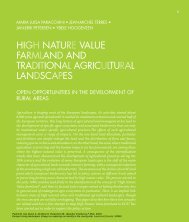The Terraced landscapes of The MalTese Islands - Landscape Europe
The Terraced landscapes of The MalTese Islands - Landscape Europe
The Terraced landscapes of The MalTese Islands - Landscape Europe
You also want an ePaper? Increase the reach of your titles
YUMPU automatically turns print PDFs into web optimized ePapers that Google loves.
6 : Terrace wall reconstruction and EU subsidies<br />
<strong>The</strong> structural integrity <strong>of</strong> Maltese terraces depends largely on the effectiveness <strong>of</strong> their retaining drystone walls. For this reason, a specific study was<br />
carried out within the CAMP process, which mapped the condition <strong>of</strong> the retaining walls. This State <strong>of</strong> Drystone Walls Map was also used as an additional<br />
layer within the Erosion GIS for the compilation <strong>of</strong> the final Physical Erosion Risk Map (Figure 15). A review <strong>of</strong> the findings concludes that, not surprisingly,<br />
the walls which exhibited most damage were those which were constructed on clay slopes. Such walls require a greater degree <strong>of</strong> maintenance, while the<br />
economic return is <strong>of</strong>ten marginal.<br />
Abandoned fields also showed considerable damage. Stormwater damage is common in such areas, but a curious finding was that some rubble<br />
walls were damaged by people while they hunted for edible snails. <strong>The</strong>y <strong>of</strong>ten overturned stones and dislodged keystones thus threatening the structural<br />
integrity <strong>of</strong> whole stretches <strong>of</strong> wall. Farmers <strong>of</strong>ten complained <strong>of</strong> this particular practice during CAMP stakeholder meetings.<br />
Drystone walls also serve as an important habitat for wildlife. Several species <strong>of</strong> reptiles and small mammals seek refuge within the walls and the<br />
maintenance <strong>of</strong> such walls needs to be appreciated as a valuable environmental measure.<br />
In recognition <strong>of</strong> these problems, the Maltese Government and the <strong>Europe</strong>an Union instituted a series <strong>of</strong> measures to persuade farmers to rebuild<br />
terrace walls. Some <strong>of</strong> these measures included legislation (Legal Notice 160 <strong>of</strong> 1997; amended by LN 169 <strong>of</strong> 2004) which specifically forbids damage to<br />
walls and their rebuilding with inferior products. In some cases, landowners used rusty oil drums, filled with loose rubble, to repair breaches in terrace<br />
walls. However, a more attractive measure was subsidies; implemented through the Rural Development Plan; which met half the cost <strong>of</strong> rebuilding walls. In<br />
this case; in order to qualify for state subsidies; farmers were asked to sign a contract guaranteeing sustainable husbandry and environmental protection<br />
(Rural Dev Plan 2004). <strong>The</strong> success <strong>of</strong> this scheme can be measured by the fact that some 723 farmers benefited from the Plan.<br />
Another interesting process is the rise in the number <strong>of</strong> small hobby farms. It seems that accelerated<br />
urbanisation has driven individuals to stake their claim to a place in whatever remains <strong>of</strong> the rural environment<br />
and they use such sites as week-end recreational retreats. This has proved to be a mixed blessing in some<br />
respects. On one hand, hobby farmers have been instrumental in maintaining terraces and rebuilding collapsed<br />
drystone walls. <strong>The</strong>y have also injected external cash into the rural economy. On the other hand, hobby<br />
farmers put enormous pressure on government authorities to be allowed to erect a variety <strong>of</strong> buildings on<br />
their properties. <strong>The</strong>se range from single rooms to elaborate farmhouses. Such constructions mar the essential<br />
rural character <strong>of</strong> the landscape and, in this respect, the Malta Environment and Planning Authority (MEPA)<br />
has been instrumental in slowing this trend by withholding the necessary development permits.<br />
Sometimes hobby farms are bought as a form <strong>of</strong> speculative investment, on the assumption that urban<br />
growth would proceed in the direction <strong>of</strong> the farm. If that were to occur, property values would soar with its<br />
re-zoning as a building development area. A related phenomenon is recreational bird hunting and trapping<br />
which has increased rapidly over the last few years. In addition, such activity has intensified over a smaller<br />
area since extensions in building development have eaten up more and more <strong>of</strong> the remaining countryside.<br />
Bird hunting normally occurs in and around cultivated terraces where some farmers may actually be hunters<br />
themselves. In fact, hunting hides and trapping sites have become a regular feature <strong>of</strong> the Maltese countryside<br />
(Figure 14). <strong>The</strong>y are highly concentrated in terraced areas overlooking the coastal cliffs but several others are<br />
located on the upper coralline limestone plateaux.<br />
Bird trapping requires the construction <strong>of</strong> trapping sites, the laying down <strong>of</strong> nets, and an elaborate trigger<br />
mechanism. All vegetation is removed from the trapping site and a hide is constructed which allows a trapper<br />
to sit while waiting to spring the trap. Besides the negative environmental impact on avifauna, the removal <strong>of</strong><br />
vegetation poses the added threat <strong>of</strong> soil erosion. Many trappers have no interest in farming and maintaining<br />
terrace walls, therefore land degradation is particularly evident around trapping sites. This sort <strong>of</strong> recreational<br />
activity also constitutes a lucrative alternative for landowners. Anecdotal evidence reveals that well-placed<br />
trapping sites on the island <strong>of</strong> Gozo are leased for annual sums reaching LM 600 (approximately €1400). This<br />
income is far more than can be realised through cultivation and, in addition, demands no effort on the part<br />
<strong>of</strong> the landowner. Perhaps a more benign change in terraced <strong>landscapes</strong> is the current trend amongst farmers<br />
<strong>of</strong> replanting terraces with vines and olives. This is a direct result <strong>of</strong> Malta’s accession to the <strong>Europe</strong>an Union<br />
Pedroli B, Van Doorn A, De Blust G, Paracchini ML, Wascher D & Bunce F (Eds. 2007).<br />
<strong>Europe</strong>’s living <strong>landscapes</strong>. Essays on exploring our identity in the countryside. LANDSCAPE EUROPE / KNNV.<br />
| 17




